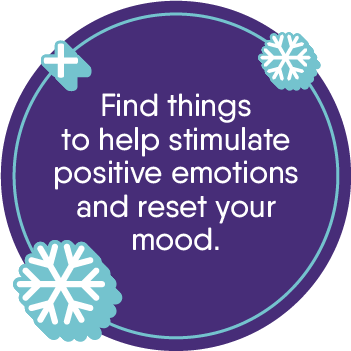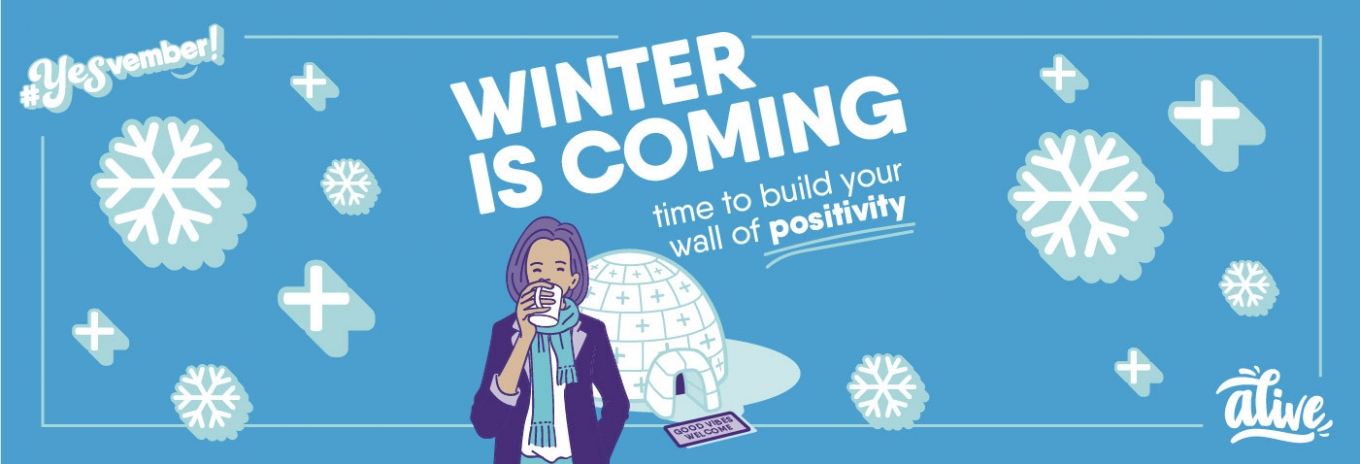As Ned Stark frequently reminded us in Game of Thrones, winter is most definitely coming. Short days, cold weather and, this year, the lingering uncertainty and restrictions of a global pandemic. It’s enough to send anyone’s mood into a downward spiral.
And it’s true. We can’t stop winter coming. We can’t change the seasons. Or a global pandemic.
But positive psychology studies show that – despite our circumstances – we can change our mood. We can reinforce our happiness defences, often with small, easy changes that have a dramatic impact on our sense of wellbeing.
 So as we enter the long months of winter, now is the time to shake up our routines and build our positivity wall.
So as we enter the long months of winter, now is the time to shake up our routines and build our positivity wall.
REFOCUS FROM NEGATIVE TO POSITIVE
When our ancestors were struggling to survive on the savannah, negativity bias played a key role in keeping them attuned to the threat of predators.
But now, our bias towards focusing on the negative can seriously jeopardise our sense of wellbeing. Here are three ways to help refocus on the positive.
Three good things
Each evening, think of three good things that happened during your day that you’re grateful for. Use a notebook, a simple app like Three Good Things or a more expansive diary app like Day One.
Gratitude journaling encourages you to actively scan for the positives in your life, rather than the seemingly more prevalent negatives. The longer you do it, the harder it is to find new things to be grateful for – so the stronger your positivity scanning muscles become!
Build a moat
Many of us face a dilemma when it comes to news: how to keep abreast of what’s going on, while avoiding the health impact of the constant barrage of negative stories? And that impact can be significant. In one study, people who watched just three minutes of negative news in the morning were 27% more likely to report their day as unhappy 6-8 hours later.
In his book Big Potential, Shawn Achor suggests ‘building a moat’ against these negative influences by making early morning and late evening news-free zones. This helps protect our mood at times when we are most vulnerable.
Create a list of awesome things
We may be missing big pleasures like holidays, nights out and family gatherings. But we can still enjoy the smaller things. So make a list of what author Neil Pasricha calls ‘awesome things’ – the little things in life to be grateful for.
Take inspiration from his own list at www.1000awesomethings.com, then create your own – and add new things as you think of them. Review your list whenever you need a boost.
GET SOCIAL
One thing we’re all missing is close contact with friends and family. And it’s not surprising: social connection is the biggest driver of happiness, as predictive of how long we’ll live as obesity or smoking. So what can we do if we can’t see as much of our family or friends?
Cultivate your ‘weak ties’
Remember the last time you had a chat with your local shop assistant or barista? Or a quick catch-up with a neighbour? Did it feel good? Research suggests people are happier on days when they personalise interactions with what sociologists call ‘weak ties’. This can be simply through smiling, making eye contact or perhaps a quick chat.
2-minute text
In a recent webinar for Action for Happiness, Shawn Achor proposed a daily 2-minute text as another way to cultivate weak ties.
 Simply pick someone from your contacts each day who you haven’t seen or talked to for a while, and send them a quick, friendly message.
Simply pick someone from your contacts each day who you haven’t seen or talked to for a while, and send them a quick, friendly message.
Reach out
When we’re under pressure or feeling down, many of us tend to turn inward – just when we would most benefit from actively seeking the support of friends and colleagues.
So if you’re struggling, don’t keep it to yourself. One study found that if you stand at the base of a hill, it looks up to 20% less steep if you’re with a friend, than if you were facing it alone.
What’s more, sharing your struggles gives your friends the green light to open up on their own challenges and experiences.
RINGFENCE YOUR WORKING DAY
Many communicators are still working remotely – and are likely to be doing so for some time. What’s more, it seems we’re busier than ever.
This can lead to an unhealthy blurring of the lines between home life and work. Establishing a transition routine between home and work can overcome this.
Create a virtual commute…
While few of us miss our daily commute, it did help create a clear separation between home and work.
According to a recent article in the Harvard Business Review, the happiest commuters were those who used their commute to plan their workday. It suggests creating a 15-minute ‘virtual commute’ to slowly get into work mode – perhaps by taking a short walk.
The benefit of a virtual commute has even led Microsoft to build it into their Teams application. According to their research, reflection during commuting time can increase productivity by 12-15%.
… and a ‘Feierabend’
In Germany, the Feierabend is the name given to after-work time – the start of which is often marked with a beer, snack or exercise. It’s seen as a way to truly disconnect from the office, rather than be tempted to check those emails later after dinner. That way, you return more refreshed and productive the next day.
CREATE HAPPINESS BOOSTERS
Positive emotions not only make us feel good, they improve our performance too. That’s why some companies furnish their offices with mood boosters like slides, table tennis tables or basketball hoops.
Happiness researcher Tal Ben-Shahar suggests creating your own happiness boosters: bite-size activities that can quickly elevate your mood. For example, you might create playlists of:
- favourite movie scenes from YouTube: one study found that just thinking about a favourite film raised endorphin levels by 27 percent
- stand-up comedians
- those feel-good songs that remind you of happy times, or are guaranteed to make you want to dance.
 Or you could do five minutes of meditation. Or yoga. Or reading a good book. Anything to help stimulate positive emotions and reset your mood.
Or you could do five minutes of meditation. Or yoga. Or reading a good book. Anything to help stimulate positive emotions and reset your mood.
So with winter coming, take a little time to prepare your defences. Gather your happiness boosters. Establish some simple new habits. And build your wall of positivity.
by Dave Wraith, Internal Communications, Employee Engagement and Change Comms Specialist.
















